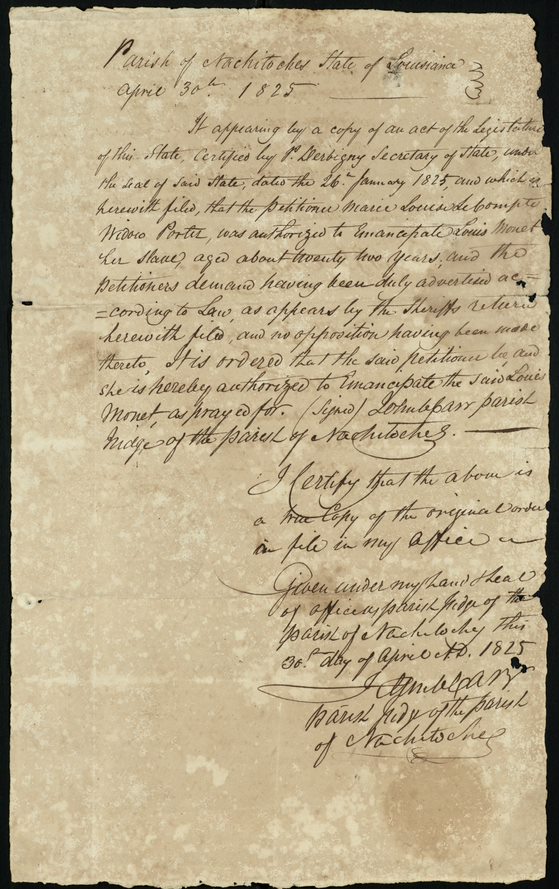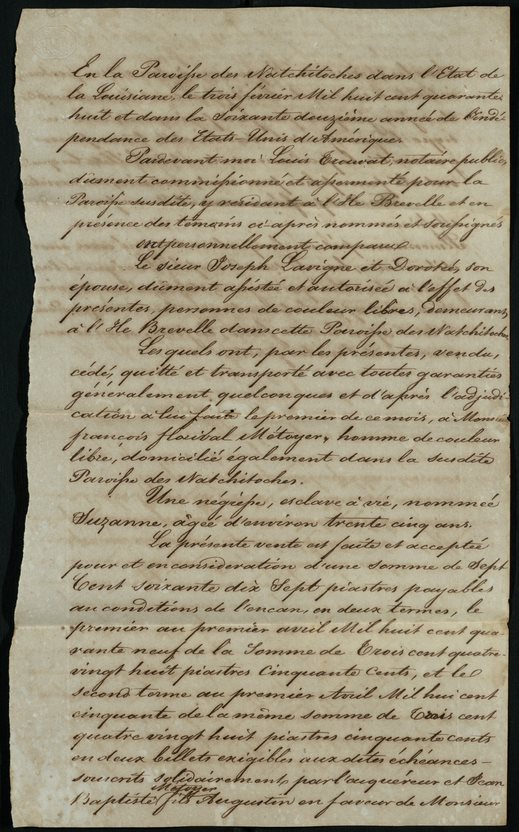Located in Natchitoches Parish, the Cane River region was originally the home of the Caddo tribe, and was culturally and economically transformed after French and Spanish colonists began claiming parts of the area in the early 18th century. The French established a colonial trading post, Natchitoches, in 1714, that became an important trade center between the French, the Spanish, and Indigenous peoples. The French further changed the landscape of the Cane River region by establishing plantations and importing enslaved Africans to clear land and cultivate crops such as rice, indigo, and, later, cotton.
An 1850 portrait of a Creole woman of color (THNOC, 2015.0464.3)
Slavery not only formed the basis of the economy of the Cane River region; it also shaped the area’s society and culture. French and Spanish planters and enslavers entered a variety of different types of relationships with enslaved people. In many cases, the children born of those relationships were granted their freedom. Many of the Creoles of color in 19th-century Cane River were descendants of Marie Thérèse Coincoin (1742–1816). An enslaved Black woman, Coincoin was emancipated by her white owner, Claude Thomas Pierre Metoyer. Metoyer granted Coincoin a yearly allowance and a parcel of land that bordered his own property. He also emancipated some of their 10 mixed-race children, deeding them land as well. As their numbers grew, Coincoin and Metoyer’s children and other mixed-race descendants of white planters and enslaved Black women formed a separate class of free people of color who lived alongside their white Creole neighbors as well as enslaved people of African descent. Though these Creoles of color were themselves descended from enslaved people, many of them became planters, owning both plantations and people.
The Cane River Collection, acquired by THNOC in 1981, includes materials from the Cane River region from around 1817 to 1859. The collection contains roughly 1,400 legal and financial documents that encapsulate everyday life within the community. The majority of the documents are in French—evidence of the enduring influence of French colonization and Creole culture. Some 169 families are mentioned in the collection, with some family names appearing frequently. Throughout the documents, multiple spellings are used for the same person. The following items from the Cane River Collection offer a snapshot of one of Louisiana’s most complex communities.

Document detailing the emancipation of Louis Mouet (THNOC, MSS 182.74)
Emancipation of Louis Mouet
The Cane River Collection contains three examples of emancipation documents. During the period in which these documents were collected, enslaved people could purchase their own freedom or be manumitted by their owners. Once emancipated, the free people of color in Cane River were able to work and live within the community.
Born in 1802, Louis Mouet was the son of a mixed-race enslaved woman—a descendant of Marie Thérèse Coincoin—and her white enslaver. Handwritten in English, this document shows that Louis Mouet was emancipated by his father’s widow when he was 22 years old. It was authorized by Louisiana Secretary of State Pierre Derbigny.
Bills of Sale
Bill of sale for Ysom, an enslaved person (THNOC, MSS 182.235)
There are a total of 147 documents in the Cane River Collection that relate to the purchasing and selling of enslaved people. This document summarizes the sale of Ysom, an enslaved person owned by Marc Sompayrac, to François Darion. Other historic plantations in this region, such as Magnolia, Melrose, and Oaklawn, have similar documents that record the purchase and sale of enslaved people. Bills of sales were written as contracts, not as actual bills or receipts. They typically included information about the name of the purchaser, their estate location, and basic information about the enslaved person. They often included the person’s sex, approximate age, and name. In this case, Ysom was about 18 years old and was sold to Darion for 550 piastre, which is roughly $15,000 in contemporary US dollars.

Bill of sale for Suzanne, an enslaved person (THNOC, MSS 182.1026)
This item documents Joseph and Dorotee Lavigne’s sale of a woman named Suzanne on February 3, 1848, to François Florival Metoyer. The Metoyer family, which descended from Coincoin’s owner, Claude Thomas Pierre Metoyer, included both white Creoles and free Black Creoles. Of all the families represented in the Cane River Collection, the Metoyers purchased and sold the highest number of enslaved people.
Estate Inventories

Inventory list for the estate of Pierre Derbanne (THNOC, MSS 182.38)
There are 56 estate inventories in the Cane River Collection. These documents served as appraisals or documentation of the contents of a home after its owner’s death. To contemporary researchers they provide a survey of the typical home furnishings at that time. This inventory lists the contents of the estate of Pierre Derbanne. Made for Derbanne’s widow, it lists kitchen supplies (frying pans, bottles, knives, pots, utensils, and plates), furniture (a bed, table with chairs, and a cupboard), household goods (candlesticks, hatchets, and picks), livestock (oxen and pigs), and farm supplies (wagon, yoke, and plow). As property, enslaved people are listed alongside land and other household goods.
Testimony about Accusations of Slander

Testimonial from trial involving Alexis Cloutier and Celestin Rachal (THNOC, MSS 182.81)
The Cane River Collection contains various testimonial documents from trials in the community. These testimonies include cases such as defamation and slander, assault and battery, theft, and medical malpractice. Though typically not lengthy or detailed, the surviving documents provide a summary of the trials.
The testimony above was inscribed and most likely spoken in French. It shows Alexis Cloutier accusing Celestin Rachal (Cloutier’s relative) and Louis Monette of defamation against his character. Cloutier, whom the nearby town of Cloutierville is named for, was a notorious, wealthy planter who became involved in several court cases. As Gary B. Mills recounts in The Forgotten People: Cane River’s Creoles of Color, in one case, Cloutier degraded and abused his wife, and in another he attempted to cancel the manumission of an enslaved woman because he was displeased by her behavior.
About The Historic New Orleans Collection
Founded in 1966, The Historic New Orleans Collection is a museum, research center, and publisher dedicated to the stewardship of the history and culture of New Orleans and the Gulf South. Follow THNOC on Facebook or Instagram.












